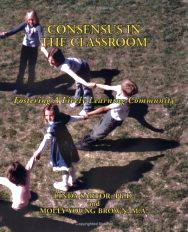 CONSENSUS IN THE CLASSROOM: Fostering a Lively Learning Community
CONSENSUS IN THE CLASSROOM: Fostering a Lively Learning Community
by Linda Sartor, Ph.D. and Molly Brown, M.A.
Born out of a passionate interest in environmental education, Linda Sartor began experimenting with consensus decision-making in her public school classrooms. She found that consensus in the classroom works as both an instructional strategy and a classroom management approach, and fosters a lively learning community. It both requires and generates a paradigm shift in a teacher’s relationship with students and students’ relationships with each other. This book will inspire and assist educators to use the consensus process in and out of the classroom.
AVAILABLE ON KINDLE!
For more information and a downloadable PDF of the book, please visit the website: www.consensusclassroom.org
YouTube link: https://youtu.be/jEueFevv-kE
CLICK HERE TO BUY THIS BOOK NOW
To order this book through online booksellers around the world, please click the following link to go to this book’s page on Global-Find-A-Book.
TABLE OF CONTENTS
Introduction — 1 Purpose of the book; Authors’ personal introductions; Overview; Use of Linda’s voice; Disclaimers and caveats.
Chapter 1: Consensus Decision-making for a Humane, Sustainable Culture — 5 Context and vision; What is consensus? Common concerns about using consensus: time consumption, power differentials; Consensus decision-making for healthy systems
Chapter 2: Consensus in Post-Modern Education — 11 The post-modern paradigm shift; Authority, democracy, and individual choice; New pedagogical understandings and challenges; Creating cooperative and multicultural learning communities; The emerging paradigm in post-modern education
Chapter 3: Benefits and Dynamics of Consensus in the Classroom — 29 Shared authority and responsibility; Enhanced self-expression; Full participation; Creative decision-making; Conscious community.
Chapter 4: Processes and Outcomes (in Linda’s Classroom) — 45 Introduction; Class meetings; The disturbance agreement; Court system; Money system; The homework decision; The Listening Game
Chapter 5: Getting Started — 57 Getting the idea accepted in the culture of the school; Introducing consensus to a class: the Yurt Circle, the homework decision, convening the first class meeting, shared vision; Common challenges: the Inevitably Long Meeting, stuck in the muck, the Blocker; Shifting from being the authority to sharing the authority; Encouraging self-expression; Attachment and resistance
Appendix: Katherine Kennedy––A Teacher’s Story — 69 Excerpts from Katherine Kennedy’s journal and report on her experience implementing consensus in her third grade classroom at an international school in Finland.
Resources and references
Praise for Consensus in the Classroom
Linda Sartor is an expert at using consensus in the classroom. In this day of regimented, soul destroying “teaching for the test,” her work in educating for consciousness, relationship, and direct democracy is crucially important. ~ Starhawk, author and social activist
It is superb. Also supremely helpful. I thank you for writing it. Your book has enlightened me about traditional group dynamics, power structures, and so on. The learning is so valuable, and so integral to the foundations of becoming a change agent. ~ Mary Hutchings, classroom teacher
Consensus in the Classroom is the most important book I can imagine for today’s schools. It introduces a paradigm that could save the floundering public school system by empowering students to govern themselves, learn to respect diversity, and creatively and constructively resolve conflict. I’ve waited for years for the arrival of this powerful resource, based on Linda’s long experience and selfless dedication. ~ John W. Travis, MD, The Alliance for Transforming the Lives of Children, author of Wellness Workbook.
In this book, the authors share their process for engaging young people in real problem-solving discussion. They inspire and edify. They open doors to their classrooms and invite us in. We come away more knowledgeable and better able to go to work. ~ Ruth Charney, Northeast Foundation for Children, author of Teaching Children to Care.
Consensus in the Classroom offers a wholly different way of thinking about the teaching/learning environment. Sartor and Brown propose a classroom in which children share decisions and responsibility, resulting in personal affirmation and empowerment. From personal experience, the authors offer a road map for development of a sense of community and deepened consciousness for all. It is not just a book for educators, but for anyone who works with groups. ~ Linda L. Simmons, Ph.D. Professor Emeritus, Fort Lewis College.
